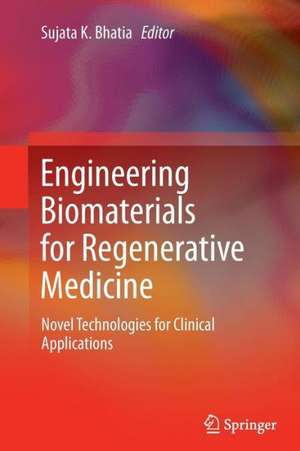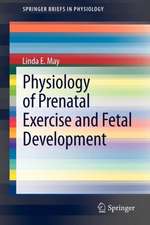Engineering Biomaterials for Regenerative Medicine: Novel Technologies for Clinical Applications
Editat de Sujata K. Bhatiaen Limba Engleză Paperback – 25 ian 2014
By integrating engineering and clinical medicine, Engineering Biomaterials for Regenerative Medicine examines how tissue engineering and regenerative medicine can be translated into successful therapies to bridge the gap between laboratory and clinic. The book will aid materials scientists and engineers in identifying research priorities to fulfill clinical needs, and will also enable physicians to understand novel biomaterials that are emerging in the clinic. This integrated approach also gives engineering students a sense of the excitement and relevance of materials science in the development of novel therapeutic strategies.
| Toate formatele și edițiile | Preț | Express |
|---|---|---|
| Paperback (1) | 947.67 lei 6-8 săpt. | |
| Springer – 25 ian 2014 | 947.67 lei 6-8 săpt. | |
| Hardback (1) | 952.89 lei 6-8 săpt. | |
| Springer – 10 noi 2011 | 952.89 lei 6-8 săpt. |
Preț: 947.67 lei
Preț vechi: 1155.69 lei
-18% Nou
Puncte Express: 1422
Preț estimativ în valută:
181.36€ • 188.64$ • 149.72£
181.36€ • 188.64$ • 149.72£
Carte tipărită la comandă
Livrare economică 14-28 aprilie
Preluare comenzi: 021 569.72.76
Specificații
ISBN-13: 9781489991041
ISBN-10: 1489991042
Pagini: 364
Ilustrații: X, 354 p.
Dimensiuni: 155 x 235 x 19 mm
Greutate: 0.51 kg
Ediția:2012
Editura: Springer
Colecția Springer
Locul publicării:New York, NY, United States
ISBN-10: 1489991042
Pagini: 364
Ilustrații: X, 354 p.
Dimensiuni: 155 x 235 x 19 mm
Greutate: 0.51 kg
Ediția:2012
Editura: Springer
Colecția Springer
Locul publicării:New York, NY, United States
Public țintă
ResearchCuprins
Preface: The clinical imperative for regenerative medicine(Sujata K. Bhatia, Harvard University).- Cellular Recruitment and Delivery.- CHAPTER 1. Biomaterial surfaces for the isolation of hematopoietic stem and progenitor cells (Srinivas D. Narasipura and Michael R. King, Cornell University).- CHAPTER 2. Matrix stiffness: A regulator of cellular behavior and tissue formation (Brooke N. Mason, Joseph P. Califano, and Cynthia A. Reinhart-King, Cornell University).- Oxygen Delivery.- CHAPTER 3. Oxygen supply for tissue engineering (Whitney L. Stoppel and Susan C. Roberts, University of Massachusetts-Amherst).- Tuning of Mechanical Properties.- CHAPTER 4. Adhesion behavior of soft materials (Santanu Kundu, National Institute of Standards and Technology, and Edwin P. Chan, University of Massachusetts-Amherst).- CHAPTER 5. PLA-PEO-PLA hydrogels and their mechanical properties(Gregory N. Tew and Surita R. Bhatia, University of Massachusetts-Amherst).- Control of Inflammation and Host Response.- CHAPTER 6. Host response to biomaterials (Anjelica L. Gonzalez-Simon, Yale University, and Omolola Eniola-Adefeso, University of Michigan).- CHAPTER 7. Modulation of the wound healing response through oxidation active materials (Paritosh P. Wattamwar and Thomas D. Dziubla, University of Kentucky).- Biologically Inspired Materials for Tissue Regeneration.- CHAPTER 8. Gecko-inspired tape-based adhesives (Woo Kyung Cho, Maria José Maio Nunes Pereira, Nora Lang, Kyungheon Lee, Shwetha Mureli, Andreas Zumbuehl, Cathryn Sundback, Peter T. Masiakos, David J. D. Carter, Jeffrey Borenstein, Lino Ferreira, Robert Langer, and Jeffrey M. Karp, Harvard-MIT).- CHAPTER 9. Heparin-functionalized materials in tissue engineering applications (Christopher McGann and Kristi Kiick, University of Delaware).- Clinical Applications of Tissue Regeneration.-CHAPTER 10. Tissue engineering strategies for vocal fold repair and regeneration (Alexandra J. E. Farran, Zhixiang Tong, Robert L. Witt, and Xinqiao Jia, University of Delaware).- CHAPTER 11. Non-viral gene delivery for applications in regenerative medicine (Kory Blocker and Millicent Sullivan, University of Delaware).- CHAPTER 12. Chitosan-based delivery system for tissue regeneration and chemotherapy (Sungwoo Kim and Yunzhi Yang, University of Texas Health Science Center).- CHAPTER 13. Conclusion: Translating tissue engineering into successful therapies (Sujata K. Bhatia, Harvard University).
Textul de pe ultima copertă
Regeneration of tissues and organs remains one of the great challenges of clinical medicine, and physicians are constantly seeking better methods for tissue repair and replacement. Tissue engineering and regenerative medicine have been investigated for virtually every organ system in the human body, and progress is made possible by advances in materials science, polymer chemistry, and molecular biology. This book reviews the current status of biomaterials for regenerative medicine, and highlights advances in both basic science and clinical practice. The latest methods for regulating the biological and chemical composition of biomaterials are described, together with techniques for modulating mechanical properties of engineered constructs. Contributors delineate methods for guiding the host response to implantable materials, and explain the use of biologically-inspired materials for optimal biological functionality and compatibility. The book culminates in a discussion of the clinical applications of regenerative medicine.
By integrating engineering and clinical medicine, Engineering Biomaterials for Regenerative Medicine examines how tissue engineering and regenerative medicine can be translated into successful therapies to bridge the gap between laboratory and clinic. The book will aid materials scientists and engineers in identifying research priorities to fulfill clinical needs, and will also enable physicians to understand novel biomaterials that are emerging in the clinic. This integrated approach also gives engineering students a sense of the excitement and relevance of materials science in the development of novel therapeutic strategies.
Details strategies for addressing specific disease states with tissue engineering and regenerative medicine
Discusses the latest generation of regenerative biomaterial
By integrating engineering and clinical medicine, Engineering Biomaterials for Regenerative Medicine examines how tissue engineering and regenerative medicine can be translated into successful therapies to bridge the gap between laboratory and clinic. The book will aid materials scientists and engineers in identifying research priorities to fulfill clinical needs, and will also enable physicians to understand novel biomaterials that are emerging in the clinic. This integrated approach also gives engineering students a sense of the excitement and relevance of materials science in the development of novel therapeutic strategies.
Details strategies for addressing specific disease states with tissue engineering and regenerative medicine
Discusses the latest generation of regenerative biomaterial
Caracteristici
Details strategies for addressing specific disease states with tissue engineering and regenerative medicine Discusses the latest generation of regenerative biomaterials Allows biomaterials researchers to understand the clinical targets and requirements for regenerative medicine Provides a multi-disciplinary approach with contributions from departments of chemical engineering, polymer science, bioengineering, and medicine Edited by an M.D./Ph.D. with an integrated perspective into both research and clinical issues Includes supplementary material: sn.pub/extras













